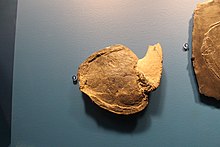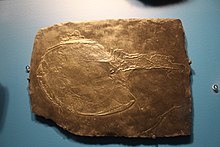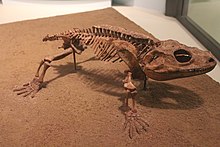
A | B | C | D | E | F | G | H | CH | I | J | K | L | M | N | O | P | Q | R | S | T | U | V | W | X | Y | Z | 0 | 1 | 2 | 3 | 4 | 5 | 6 | 7 | 8 | 9
 The Field Museum's south front | |
| Established | June 2, 1894[1] |
|---|---|
| Location | Near South Side, Chicago, United States |
| Coordinates | 41°51′58″N 87°37′01″W / 41.86611°N 87.61694°W |
| Visitors | 1,018,000 (2022)[2] |
| President | Julian Siggers |
| Public transit access | at Museum Campus/11th Street Red Orange Green |
| Website | www |
Field Museum of Natural History | |
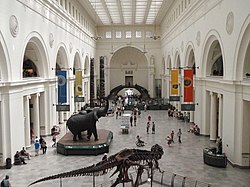 Stanley Field Hall | |
| Built | 1921 |
| Architect | Daniel Burnham, Pierce Anderson |
| Architectural style | Classical Revival |
| NRHP reference No. | 75000647[3] |
| Added to NRHP | September 5, 1975 |
The Field Museum of Natural History (FMNH), also known as The Field Museum, is a natural history museum in Chicago, Illinois, and is one of the largest such museums in the world.[4] The museum is popular for the size and quality of its educational and scientific programs,[5][6] and its extensive scientific specimen and artifact collections.[7] The permanent exhibitions,[8] which attract up to 2 million visitors annually, include fossils, current cultures from around the world, and interactive programming demonstrating today's urgent conservation needs.[9][10] The museum is named in honor of its first major benefactor, Marshall Field, the department-store magnate. The museum and its collections originated from the 1893 World's Columbian Exposition and the artifacts displayed at the fair.[11][12]
The museum maintains a temporary exhibition program of traveling shows as well as in-house produced topical exhibitions.[13] The professional staff maintains collections of over 24 million specimens and objects that provide the basis for the museum's scientific-research programs.[4][7][14] These collections include the full range of existing biodiversity, gems, meteorites, fossils, and extensive anthropological collections and cultural artifacts from around the globe.[7][15][16][17] The museum's library, which contains over 275,000 books, journals, and photo archives focused on biological systematics, evolutionary biology, geology, archaeology, ethnology and material culture, supports the museum's academic-research faculty and exhibit development.[18] The academic faculty and scientific staff engage in field expeditions, in biodiversity and cultural research on every continent, in local and foreign student training, and in stewardship of the rich specimen and artifact collections. They work in close collaboration with public programming exhibitions and education initiatives.[14][19][20][21]
History

In 1869, and before its formal establishment, the museum acquired the largest collection of birds and bird descriptions, from artist, and ornithologist Daniel Giraud Elliot. In 1894, Elliot would become the curator of the Department of Zoology at the museum, where he worked until 1906.[22][23]
In order to house, for future generations, the exhibits and collections assembled including those for the World's Columbian Exposition, Edward Ayer convinced a merchant named Marshall Field to fund the establishment of a museum.[11][12][24] Originally titled the Columbian Museum of Chicago in honor of its origins, the Field Museum was incorporated by the State of Illinois on September 16, 1893, for the purpose of the "accumulation and dissemination of knowledge, and the preservation and exhibition of artifacts illustrating art, archaeology, science and history".[25] The Columbian Museum of Chicago occupied the only building remaining from the World's Columbian Exposition in Jackson Park, the Palace of Fine Arts. It is now home to the Chicago Museum of Science and Industry.[10]
In 1905, the museum's name was changed to Field Museum of Natural History to honor its first major benefactor and to reflect its focus on the natural sciences.[26]

Stanley Field was the president in 1906.[27]
During the period from 1943 to 1966,[28][29][30] the museum was known as the Chicago Natural History Museum. In 1921, the Museum moved from its original location in Jackson Park to its present site on Chicago Park District property near downtown Chicago.[31] By the late 1930s the Field Museum had emerged as one of the three premier museums in the United States, the other two being the American Museum of Natural History in New York City and the National Museum of Natural History at the Smithsonian Institution in Washington, DC.[5]
The museum has maintained its reputation through continuous growth, expanding the scope of collections and its scientific research output, in addition to its award-winning exhibitions, outreach publications, and programs.[6][14][19][32] The Field Museum is part of Chicago's lakefront Museum Campus that includes the John G. Shedd Aquarium and the Adler Planetarium.[9]
In 2015, it was reported that an employee had defrauded the museum of $900,000 over a seven-year period to 2014.[33]

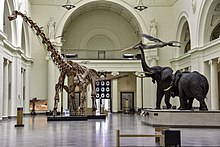

Attendance
The Museum received 1,018,002 visitors in 2022, ranking it 11th in the List of most-visited museums in the United States.[34]
Permanent exhibitions
Animal Halls
Animal exhibitions and dioramas such as Nature Walk, Mammals of Asia, and Mammals of Africa allow visitors an up-close look at the diverse habitats that animals inhabit. Most notably featured are the man-eating lions of Tsavo.[35] The Mfuwe man eating lion is also on display.
| Species represented in the Animal Halls | Gallery |
|---|---|
| Aardvark | Mammals of Africa |
| African Buffalo | Mammals of Africa |
| African Elephant | Stanley Field Hall |
| Alaskan Brown Bear | Messages from the Wilderness |
| Argali | Mammals of Asia |
| Barasingha | Mammals of Asia |
| Beaver | Messages from the Wilderness |
| Beisa Oryx | Mammals of Africa |
| Bengal Tiger | Mammals of Asia |
| Blackbuck Antelope | Mammals of Asia |
| Black Rhinoceros | Mammals of Africa |
| Black Wildebeest | Mammals of Africa |
| Bongo | Mammals of Africa |
| Burchell's Zebra | Mammals of Africa |
| Capybara | Messages from the Wilderness |
| Caribou | Messages from the Wilderness |
| Caribbean Manatee | Sea Mammals |
| Cattle Egret | Mammals of Asia |
| Cheetah | Mammals of Africa |
| Chital | Mammals of Asia |
| Common Eland | Mammals of Africa |
| Cougar | Messages from the Wilderness |
| Dibatag | Mammals of Africa |
| Lion | Mammals of Africa |
| Elephant Seal | Sea Mammals |
| Gaur | Mammals of Asia |
| Gelada Baboon | Mammals of Africa |
| Gerenuk | Mammals of Africa |
| Giant Anteater | Messages from the Wilderness |
| Giant Forest Hog | Mammals of Africa |
| Giant Panda | Mammals of Asia |
| Giant Sable Antelope | Mammals of Africa |
| Glacier Bear | Messages from the Wilderness |
| Grant's Gazelle | Mammals of Africa |
| Greater Kudu | Mammals of Africa |
| Guanocos | Messages from the Wilderness |
| Hog Deer | Mammals of Asia |
| Hyacinth Macaws | Messages from the Wilderness |
| Ibex | Mammals of Asia |
| Imperial Woodpecker | Messages from the Wilderness |
| Indian Gazelle | Mammals of Asia |
| Indian Rhinoceros | Mammals of Asia |
| Indian Sambar | Mammals of Asia |
| Jaguar | Messages from the Wilderness |
| Leopard | Mammals of Asia |
| Lesser Kudu | Mammals of Africa |
| Mantled Guereza | Mammals of Africa |
| Malay Tapir | Mammals of Asia |
| Marsh Deer | Messages from the Wilderness |
| Mexican Grizzly Bear | Messages from the Wilderness |
| Mountain Nyala | Mammals of Africa |
| Mule Deer | Messages from the Wilderness |
| Muskoxen | Messages from the Wilderness |
| Narwhal | Sea Mammals |
| Nilgai | Mammals of Asia |
| Northern Fur Seal | Sea Mammals |
| Orangutan | Mammals of Asia |
| Plains Zebra | Mammals of Africa |
| Polar Bear | Messages from the Wilderness |
| Proboscis Monkey | Mammals of Asia |
| Pronghorn | Messages from the Wilderness |
| Reticulated Giraffe | Mammals of Africa |
| Roosevelt Elk | Messages from the Wilderness |
| Sea Otter | Sea Mammals |
| Sloth Bear | Mammals of Asia |
| Snow Leopard | Mammals of Asia |
| Somali Wildass | Mammals of Africa |
| Spotted Hyena | Mammals of Africa |
| Striped Hyena | Mammals of Asia |
| Swayne's Hartebeest | Mammals of Africa |
| Takin | Mammals of Asia |
| Tapir | Messages from the Wilderness |
| Thomas' Uganda Kob | Mammals of Africa |
| Walrus | Sea Mammals |
| Wart Hog | Mammals of Africa |
| Water Buffalo | Mammals of Asia |
| Weddell Seal | Sea Mammals |
| White Rhinoceros | Mammals of Africa |
| Yellow-checked Gibbon | Mammals of Asia |
Evolving Planet
Evolving Planet follows the evolution of life on Earth over 4 billion years. The exhibit showcases fossils of single-celled organisms, Permian synapsids, dinosaurs, extinct mammals, and early hominids.[36] The Field Museum's non-mammalian synapsid collection consists of over 1100 catalogued specimens, including 46 holotypes. The collection of basal synapsids includes 29 holotypes of caseid, ophiacodontid, edaphosaurid, varanopid, and sphenacodontid species – approximately 88% of catalogued specimens.[37]




